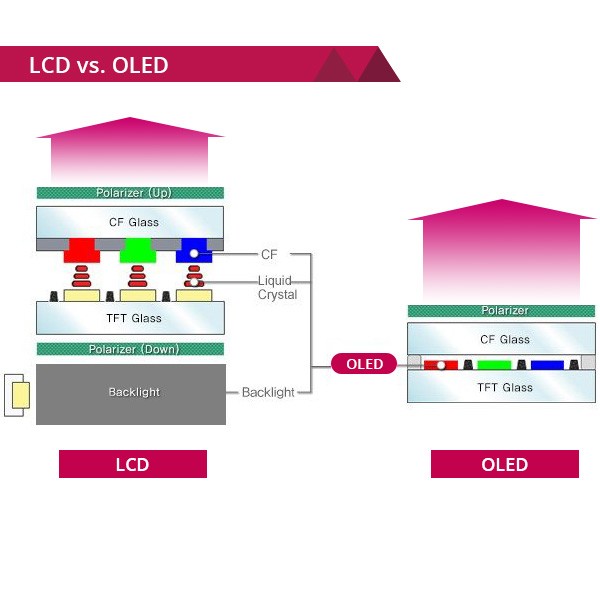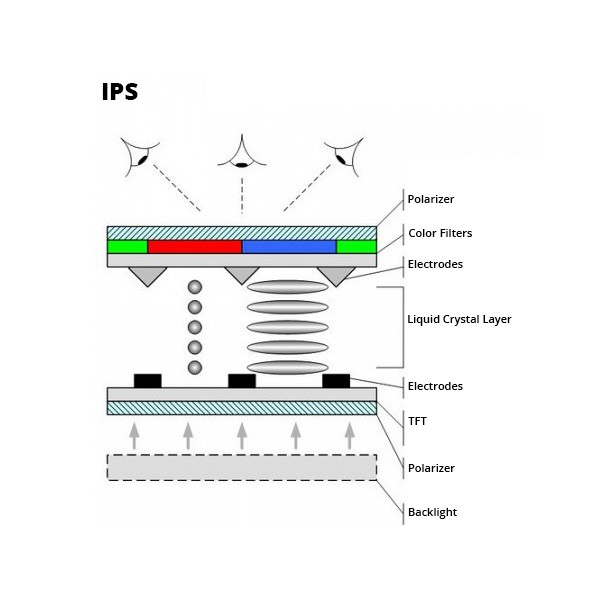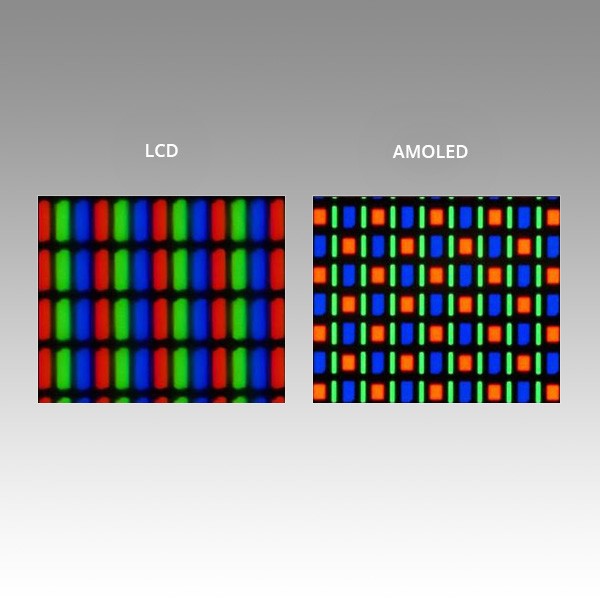Modern Technologies of Manufacturing Displays
When choosing a smartphone or spare part (especially a display), one must take into account one of the most important parameters – the type of a display.
If you decide to buy a matrix or a display module, always first specify which type of display your gadget uses. Now the market has a huge number of spare parts with different quality classes and prices. For example, for one Samsung model, you can buy both an original AMOLED display and a TFT copy. Depending on the technology, the quality of the parts and the price will be different.
To understand and help you make your choice, we have prepared this article. It will consider the following questions:
- what technologies do manufacturers use in the year of 2018
- what is the difference between IPS displays and AMOLED? Can they be compared at all
- what are advantages and disadvantages of modern technologies
Current Technologies in Manufacturing Displays
LCD, TFT, IPS, OLED, Super AMOLED, POLED. This is a list of the most popular technology names used today in the display production. Let us familiarize with them in more details.

LCD
LCD (Liquid Crystal Display) – a display with liquid crystals (hence the name LCD).
LCD-display consists of:
- backlight (usually LED)
- matrix transistors
- layer of liquid crystals
- color filter
- polarization film
The image is created after the light hits the crystals. Depending on the electric field applied, the position of crystals changes, and they transmit or do not transmit light through the polarization filter.
To create a color image the LCD matrix uses an array of pixels. For the operation of each pixel, there are three transistors (red, green and blue) and a capacitor. The combination of three subpixels (red, blue and green) in each pixel allows you to produce any other shade or color. The main advantages of LCD displays are their reasonable price, high brightness and clarity of the image. Also in the LCD displays, there is no color registration and screen flicker.
TFT
TN (Twisted Nematic) and IPS (In-plane Switching) are modified versions of TFT (Thin Film Transistor) displays, and they belong to the LCD technology. Therefore, it is inappropriate to compare TFT and IPS technologies. The misunderstanding occurred because TN was first discarded and the characteristics read simply TFT. After the IPS technology appeared, they continued to indicate TFT in the stores selling equipment, implying the TN-TFT technology, and IPS was indicated separately, as if it were another technology. Thus the confusion.
Let's see how these technologies differ and what their advantages are.
TN-TFT and IPS (Retina, Super IPS)
Both TN-TFT and IPS are technologies for manufacturing screens using liquid crystals and thin-film transistors.

In TN-TFT displays, between the two glass panels, the crystals are spiraled. The electrodes are located on both sides. If the transistor transfers the maximum voltage, the crystals change position, and a black pixel appears on the screen. If there is no voltage, the crystals are located at an angle of 90 to each other and form white pixels.
In IPS technology, the principle is practically the same as in TN-TFT, only the crystals are initially located parallel to each other and coplanar with electrodes. If there is no voltage, the crystals remain fixed (immovable).

IPS technology has increased the quality of LCD displays, allowed for increasing viewing angles, color reproduction and increased contrast.
This technology proved more successful compared to TN-TFT, and it continues to be improved. TN displays are slowly disappearing from the market.
In IPS screens, the black color is more intense and the white color is maximum pure, which makes the picture clear and natural.
The viewing angles in IPS displays are the largest, while the image is not distorted and there is no discoloration.
Super IPS
Super IPS is another popular sub-class of IPS displays. Initially, in IPS displays, the response time was quite long, and by this parameter, they were significantly behind TN displays. After some time, the developers were able to improve the technology, and there were Super IPS displays. This type of screens shows fairly high response time. Colors became even more natural, the contrast and clarity of the image increased. Now the Super IPS matrix is at times better than the first IPS displays.
IPS has its drawbacks like all technologies. Compared to TN-TFT, the technology of IPS screens is more expensive and consumes more battery power. As to power consumption, modern IPS matrices almost do not consume current. The main power consumer is a diode light. Fixed power consumption allows you to consume the same amount of battery when watching a movie, when exchanging messages, when surfing the Internet, etc.
Retina
IPS technology is used in displays known as Retina (the retina of the eye). This word was chosen not by chance. At the iPhone 4 presentation, Steve Jobs said that the human eye does not distinguish pixels when the display pixel density is more than 300. These matrices became famous after Apple used them in iPhone 4. The developers were able to separate the pixels and subpixels and achieved high density.
The pixel density in Retina displays is 220 and above, which makes them invisible on the screen for the human eye. By contrast and saturation of colors, the picture looks like a page from a glossy magazine and very realistic.
This development has turned out so successful that even in modern devices Apple continues to use these displays.
The Retina name was patented by Apple, but this is not the name of the IPS technology sub-class. For example, the iPhone X display is called Super Retina HD, although an OLED display is used.
OLED (Organic Light-Emitting Diode)
OLED technology uses diodes to produce displays. Red, green and blue diodes form a pixel, which is controlled by a special controller. This technology has long stayed in the background, as it was not possible to properly manage a large number of diodes. The breakthrough happened when it became possible to control each sub-pixel separately using a thin-film transistor and a capacitor. In this way the world-class AMOLED displays appeared.
AMOLED (Active Matrix)
In AMOLED displays, two transistors operate simultaneously with a diode. The first one transmits and returns the signal from the capacitor, and the signal from the diode to the screen is transmitted from the second capacitor. The black color appears when there is no signal and the diode does not work. This system allows you to make the black color saturated to the most. Maximum viewing angles are provided by diodes, which are located quite close to the surface of the screen. However, if you shift the axis, colors are distorted and can produce other shades.
The first AMOLED displays produced an overly vivid picture, which caused eyestrain up to painful sensations. Over time, developers have eliminated virtually all of these blunders.
Modern AMOLED matrices produce colors as close as possible to natural ones, and no longer cause tension in the eyes. In addition, compared to the LCD, they are thin, which allows you to reduce the thickness of the smartphone itself.
POLED
After the enhancement of OLED technology, LED screens became of great demand. First, they do not consume battery power, like LCD displays. Secondly, they are used for frameless and curved smartphones. To install these displays in curved smartphones, the glass substrate was replaced with a plastic one, and they were called POLED after that, where the first letter P means plastic. Screens that are manufactured using the POLED technology are more expensive, and they are thinner than even AMOLED screens.
Super AMOLED
Super AMOLED is the development and commercial move of Samsung. At first Samsung produced only AMOLED displays. Then they eliminated the air layer between the matrix and the touch screen in the AMOLED matrix, which allowed for avoiding the image distortion after the shift of the view axis and for improving the color rendering and brightness. Super AMOLED is not a separate technology. As in the case of Retina, this is a small revision with a famous commercial name.
AMOLED and IPS: Advantages and Disadvantages

At present, two leading technologies for display production – OLED and LCD – are competing on the market, while AMOLED and IPS are their advanced versions.
Among all LCD displays, IPS is considered the best. The main advantages are:
- transmission of colors with maximum accuracy (IPS matrix has the largest coverage of color shades, which allows you to design the screen images with the most realistic colors.)
- fixed charge of the battery (liquid crystals practically do not use the current. Backlight diodes consume power. The power consumption is directly proportional to the backlight level, and not to the reproduced image on the display. Stable power consumption in the IPS screen allows using approximately the same amount of current when watching movies and when writing SMS-messages, etc.).
- long lifetime (liquid crystals are resistant to aging and do not fade like diodes in AMOLED displays.) Over time, the color of the diode light may change, but this will not happen in a year or two. Burnout of the backlight may occur after 5-6 years of the daily smartphone use.)
- affordable price (LCD technology has been popular for many years; most of smartphone companies have mastered it, thus making the mass production of displays affordable).
The disadvantages of IPS matrices include:
Now, brief info about the pros of modern AMOLED matrices:
- saturated black color (diodes do not just flash to create black, so AMOLED screens transmit the maximum depth of black.).
- independent work of pixels (each pixel is a separate light source and the system controls them independently of each other.)
- instantaneous response time (the response time of the pixel in the active matrix is much faster than in IPS. High-speed frame change makes the picture more dynamic and smooth, which is important for games or virtual reality playback.).
- low battery power consumption (when displaying darker tones, AMOLED screens use less power than IPS. However, when displaying the white color, diode matrices can consume battery power even faster than IPS matrices.)
- low thickness of the display module (in modern AMOLED matrices there is no layer that diffuses the backlight light on liquid crystals. It has enabled reducing the size of the display module and the smartphone itself.)
The drawbacks of AMOLED matrices include:
- blue diodes burnout
- burnout of diodes during a long display of a static picture
- controlled blinking of pixels
It is inappropriate to compare AMOLED and IPS matrices, because they are absolutely different technologies with different resultorienting. The choice of the device and its stuffing always remains with the client.
You will find both AMOLED and IPS displays at our store. We have expanded the range of spare parts with different quality classes so that you can find the most suitable part for your smartphone in the price-quality ratio. You can buy displays and display modules on our website in the Displays section. Choose and buy!
By All Spares Team